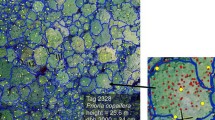Abstract
A major gap in our knowledge of plant communities is how much of their volume is occupied by plant material (stem, leaf or reproductive structure). This is basic knowledge and may be crucial for the concept of competition for space. We sampled two grassland communities and two shrublands in both Italy and New Zealand. The height of the canopy was measured by a point quadrat method, and the volume of plant material, after cutting, by displacement of water. From 0.5% to 2.9% of the canopy was occupied by plant material. Occupancy was lower in the Italian communities, which we tentatively attribute to the climate. It did not differ significantly between grasslands and shrublands. Our data suggest that physical space is probably never limiting by itself in terrestrial higher-plant communities, so that competition for space, distinct from competition for resources such as light, water and nutrients, is not likely to exist.
Similar content being viewed by others
References
Acosta A., Blasi C., Di Marzio P. &Mazzoleni S. (1996): Architectural patterns of “macchia” shrubs in Mediterranean Italy.Coenoses 11: 69–72.
Clements F.E., Weaver J.E. &Hanson H.C. (1929):Plant competition: an analysis of community functions. Carnegie Institute, Washington.
de Rereffye P. &Houllier F. (1997): Modelling plant growth and architecture: Some recent advances and applications to agronomy and forestry.Curr. Sci. 73: 984–992.
Ezcurra E., Montaña C. &Arizaga S. (1991). Architecture, light interception, and distribution of Larrea species in the Monte desert, Argentina.Ecology 72: 23–34.
Faliński J.B. (1973): Herb layer filling by plant cormus in theQuerco-Carpinetum community in the Bialowieża National Park.Phytocoenosis 2: 123–142.
Greig-Smith P. (1983):Quantitative plant ecology. Ed. 3. Blackwell, Oxford.
Grime J.P. (1977): Evidence for the existence of three primary strategies in plants and its relevance to ecological and evolutionary theory.Amer. Naturalist 111: 1169–1194.
Grist E.P.M. (1999): The significance of spatio-temporal neighbourhood on plant competition for light and space.Ecol. Modell. 121: 63–78.
Guillén D.F., de las Heras P., Herrera P. &Pineda F.D. (1994): Shrub architecture and occupation of space in a Mediterranean sclerophyllous shrubland.J. Veg. Sci. 5: 497–504.
Hestmark G., Schroeter B. &Kappen L. (1997): Intrathalline and size-dependent patterns of activity inLasallia pustulata and their possible consequences for competitive interactions.Funct. Ecol. 11: 318–322.
Huth A. &Ditzer T. (2000): Simulation of the growth of a lowlandDipterocarp rain forest with FORMIX3.Ecol. Modell. 134: 1–25.
Klimeš L. (1995): Small-scale distribution of species richness in a grassland (Bílé Karpaty Mts., Czech Republic).Folia Geobot. Phytotax. 30: 499–510.
Kubíková J. &Rejmánek M. (1973): Notes on some quantitative methods in the study of plant community structure.Preslia 45: 154–164.
Lamont B.B., Hopkins A.J.M. &Hnatiuk R.J. (1984): The flora — composition, diversity and origins. In:Pate J.S. &Beard J.S. (eds.),Kwongan, plant life of the sandplain, University of Western Australia Press, Nedlands, pp. 27–50.
Lepš J. (1995): Variance deficit is not reliable evidence for niche limitation.Folia Geobot Phytotax. 30: 455–459.
Newman E.I. (1983): Interactions between plants. In:Lange O.L., Nobel P.S., Osmond C.B. &Ziegler H. (eds.),Encyclopedia of plant physiology, New Series, Volume 12C: Physiological plant ecology III., Springer-Verlag, Berlin, pp. 679–710.
Niklas K.J. (1992):Plant biomechanics: an engineering approach to plant form and function. University of Chicago Press, Chicago.
Pickett S.T.A. &Kempf J.S. (1980): Branching patterns in forest shrubs and understorey trees in relation to habitat.New Phytol. 86: 219–228.
Silvertown J., Holtier S., Johnson J. &Dale P. (1992): Cellular automaton models of interspecific competition for space—the effect of pattern on process.J. Ecol. 80: 527–534.
Tolliver K.S., Colley D.M.. &Young D.R. (1995): Inhibitory effects ofMyrica cerifera onPinus taeda.Amer. Midl. Naturalist 133: 256–263.
Vasseur L., Irwin D.L. &Aarssen L.W. (1995): Size versus number of offspring as predictors of success under competition inLemna minor (Lemnaceae).Ann. Bot. Fenn. 32: 169–178.
Vilà M. &Sardans J. (1999): Plant competition in mediterranean-type vegetation.J. Veg. Sci. 10: 281–294.
Wilson J.B. (1995): Testing for community structure: a Bayesian approach.Folia Geobot. Phytotax. 30: 461–469.
Wilson J.B., Steel J.B., Newman J.E. &King W.McG. (2000): Quantitative aspects of community structure, examined in a semi-arid grassland.J. Ecol. 88: 749–756.
Author information
Authors and Affiliations
Corresponding author
Rights and permissions
About this article
Cite this article
Chiarucci, A., Mistral, M., Bonini, I. et al. Canopy occupancy: How much of the space in plant communities is filled?. Folia Geobot 37, 333–338 (2002). https://doi.org/10.1007/BF02805215
Received:
Revised:
Accepted:
Issue Date:
DOI: https://doi.org/10.1007/BF02805215




